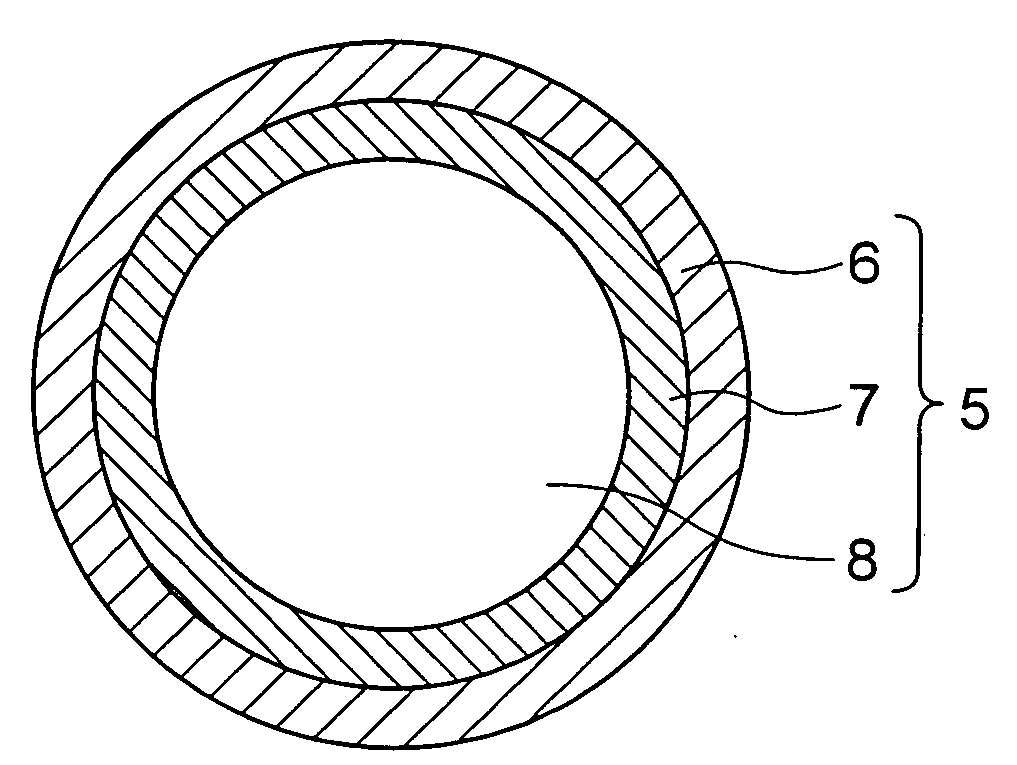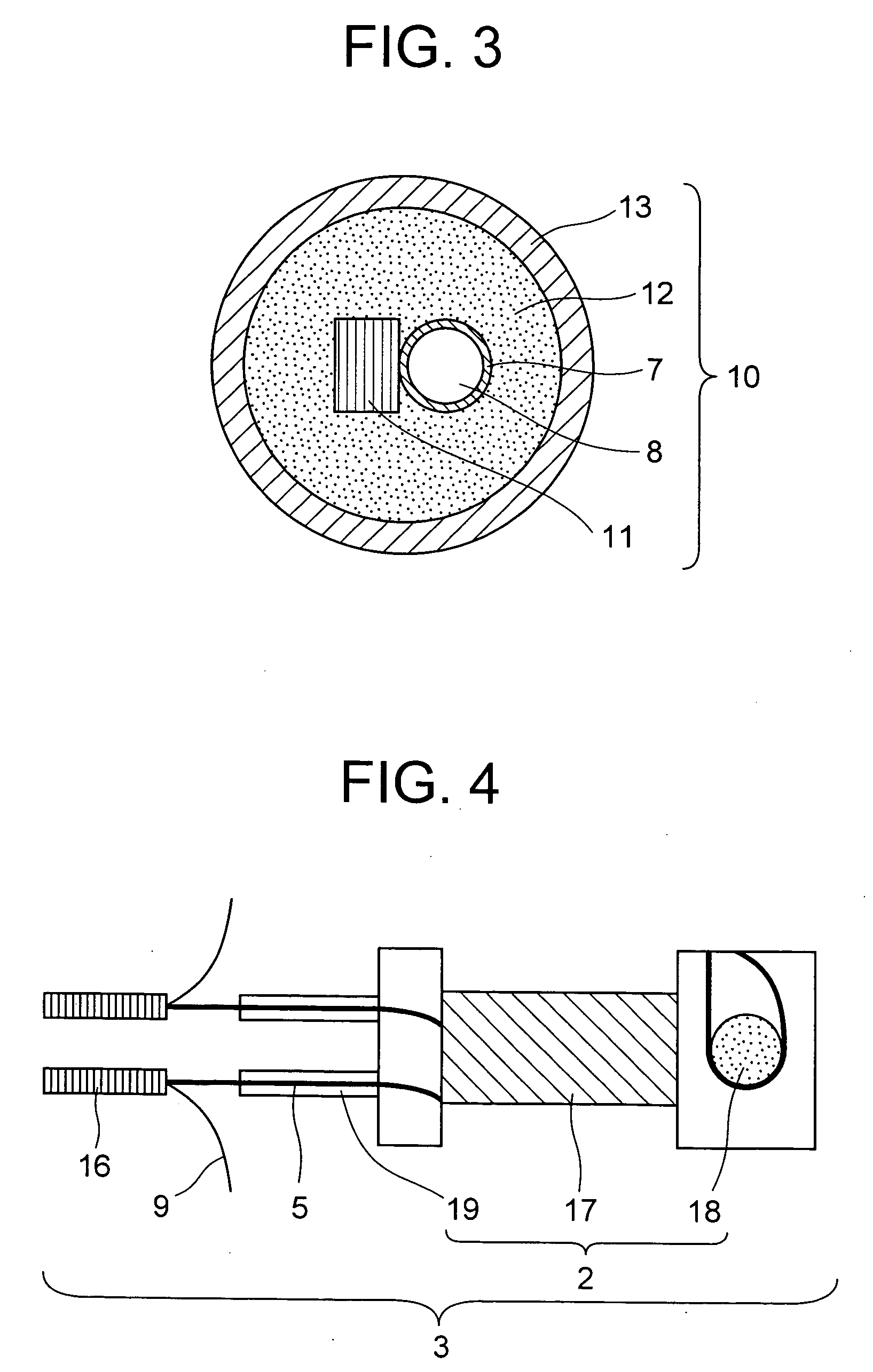Permanent current switch
a permanent current switch and current current technology, applied in the direction of superconducting magnets/coils, magnetic bodies, magnetic materials, etc., can solve the problem of inability to prepare resistance values, and achieve high reliability, thermal stability, and high temperature margin
- Summary
- Abstract
- Description
- Claims
- Application Information
AI Technical Summary
Benefits of technology
Problems solved by technology
Method used
Image
Examples
example 1
[0042]FIG. 2 shows a sectional structure of a magnesium diboride superconducting wire (an MgB2 wire) in the present embodiment.
[0043]An MgB2 wire 5 is constituted of a high-resistance metal 6, a superconducting metal 7, and a magnesium diboride superconducting portion (an MgB2 portion) 8. It is to be noted that the MgB2 wire 5 preferably has a diameter of about 0.3 mm to 2.5 mm.
[0044]FIG. 3 shows a sectional structure of a superconductive connecting section 10 superconductively connected to this MgB2 wire 5 and a superconducting wire for a wiring line.
[0045]According to this structure, the superconducting metal 7 constituting the MgB2 wire is connected to a superconducting core portion 11 constituting the superconducting wire for the wiring line via a low-melting superconducting alloy 12 in a superconductive connection tube 13.
[0046]FIG. 4 shows a permanent current switch 3 in the present embodiment.
[0047]This permanent current switch 3 has a superconducting coil 2 and a superconduc...
example 2
[0113]An MgB2 wire 5 was prepared in the same manner as in Example 1 except that NbTi was used in a superconducting metal 7 of the MgB2 wire 5 used in Example 1 in order to improve Jc of the MgB2 wire 5. Subsequently, a permanent current switch 3 was prepared.
[0114]Moreover, the switch was superconductively connected to a superconducting wire 9 for a wiring line (an NbTi wire), and further connected to a superconducting coil 2 made of NbTi and an NbTi wire 23 for a current lead to prepare a closed circuit loop, and a permanent current test was performed.
[0115]FIG. 7 shows a relation between a time and a permanent current as an experiment result.
[0116]As a representative, a result of an energization current of 1000 A is shown. Measurement was performed for ten hours.
[0117]As a result of the measurement, it has been found that transfer to a normal conducting state did not occur even once during a permanent current operation, there was hardly a current decay and the whole closed circui...
example 3
[0124]To pass a large current through an MgB2 wire 5, the MgB2 wire was constituted to have multiple cores.
[0125]FIG. 8 shows one example of a multi-core MgB2 wire 24.
[0126]The multi-core MgB2 wire 24 has a structure in which each MgB2 portion 8 is surrounded with a superconducting metal 7, and a plurality of MgB2 portions are arranged in a high-resistance metal 6. After preparing this multi-core MgB2 wire 24, a permanent current switch 3 was prepared. It is to be noted that the MgB2 portion 8 coated with the superconducting metal 7 will be referred to as an MgB2 core.
[0127]Moreover, this structure was super-conductively connected to a superconducting wire 9 for a wiring line (an NbTi wire), and further superconductively connected to a superconducting coil 2 made of NbTi and an NbTi wire 23 for a current lead to prepare a closed circuit loop, and a permanent current test was performed.
[0128]It is to be noted that even in the multi-core MgB2 wire 24, superconductive connection is per...
PUM
| Property | Measurement | Unit |
|---|---|---|
| critical temperature | aaaaa | aaaaa |
| critical temperature | aaaaa | aaaaa |
| critical temperature | aaaaa | aaaaa |
Abstract
Description
Claims
Application Information
 Login to View More
Login to View More - R&D
- Intellectual Property
- Life Sciences
- Materials
- Tech Scout
- Unparalleled Data Quality
- Higher Quality Content
- 60% Fewer Hallucinations
Browse by: Latest US Patents, China's latest patents, Technical Efficacy Thesaurus, Application Domain, Technology Topic, Popular Technical Reports.
© 2025 PatSnap. All rights reserved.Legal|Privacy policy|Modern Slavery Act Transparency Statement|Sitemap|About US| Contact US: help@patsnap.com



